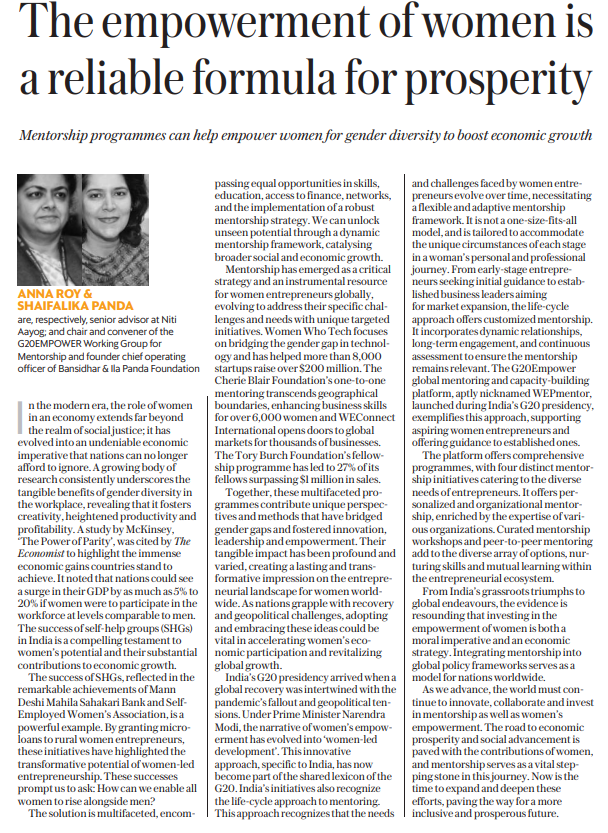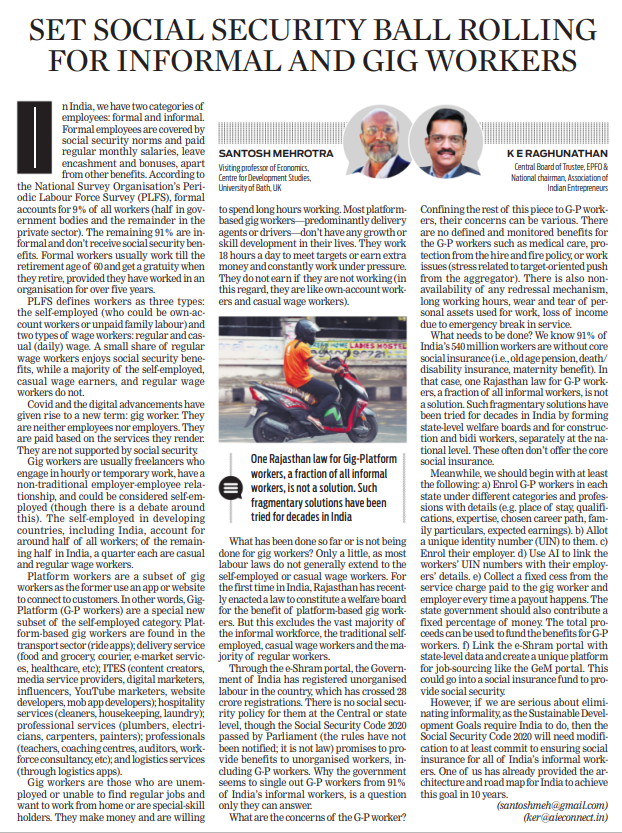INDIA'S G-20 PRESIDENCY: NURTURING A HUMAN-CENTRIC GLOBAL FUTURE
Introduction:
Vasudhaiva Kutumbakam – The Philosophy of One World Family
- The phrase “Vasudhaiva Kutumbakam,” which translates to “the world is one family,” encapsulates a profound philosophy that promotes a universal outlook, transcending borders, languages, and ideologies.
- During India’s G-20 Presidency, this philosophy has been put into action by advocating for human-centric progress, nurturing the planet as One Earth, and supporting one another as One Family.
A Changing World Order Post-Pandemic
The post-pandemic world order differs significantly from the pre-pandemic era, marked by three pivotal changes:
- Shifting from GDP Centric to Human-Centric View
– Recognizing the need to move away from a sole focus on GDP towards a human-centric approach to global development.
- Emphasis on Resilience and Reliability in Supply Chains
– Acknowledging the importance of building resilient and reliable global supply chains to ensure stability in times of crisis.
- Reforming Global Institutions and Boosting Multilateralism
– Advocating for reforms in global institutions to enhance multilateralism and cooperation among nations.
Catalyzing Mindset Shift and Inclusivity
India’s G-20 Presidency has played a catalytic role in these global shifts by prioritizing the following:
Mainstreaming Marginalized Aspirations
– Promoting the inclusion of developing countries, the Global South, and Africa by organizing initiatives like the Voice of Global South Summit.
African Union’s Permanent Membership
– Advocating for the African Union’s inclusion as a permanent member of the G-20, reflecting a commitment to equitable representation.
Accelerating Progress on Sustainable Development Goals (SDGs)
Recognizing the interlinked challenges in an interconnected world, the G-20 2023 Action Plan on Accelerating Progress on SDGs is poised to guide the G-20’s efforts in implementing the SDGs.
Climate Action and Sustainability
India’s historical commitment to harmony with nature and climate action is a foundation for its global initiatives:
Climate Action Complemented by Development
Emphasizing that climate action should complement the development stages of various Global South countries, backed by climate finance and technology transfer.
From Restrictive to Constructive Climate Approach
Advocating for a shift from a restrictive attitude to a constructive approach in the fight against climate change.
Sustainable Blue Economy and Global Hydrogen Ecosystem
Initiatives such as the Chennai High Level Principles for a Sustainable and Resilient Blue Economy and a global ecosystem for clean and green hydrogen showcase India’s commitment to environmental sustainability.
Democratizing Climate Action and Lifestyles for Sustainable Environment
Encouraging individual responsibility for climate action through initiatives like Lifestyles for Sustainable Environment (LiFE), akin to the global mass movement of Yoga for wellness.
Ensuring Food and Nutritional Security
Promoting millets and climate-smart agriculture to address food and nutritional security challenges, exemplified by the International Year of Millets and the Deccan High Level Principles on Food Security and Nutrition.
Inclusive Technology for All
India highlights the need to make technology inclusive, with a focus on narrowing inequalities:
Leveraging Technology for Inclusion
Showcasing India’s achievements in using technology to empower marginalized populations, such as digital public infrastructure (DPI) for financial inclusion.
Bridging the Gender Digital Divide
Promoting gender equality by working on reducing labor force participation gaps and enabling greater female leadership and decision-making.
G-20 Presidency: A People-Driven Movement
India’s G-20 Presidency has extended its reach across the nation and the world, involving over 200 meetings in 60 Indian cities, hosting delegates from 125 countries.
This people-driven movement seeks to bridge divides, dismantle barriers, and promote global collaboration.
Conclusion: India’s Pledge to a United Global Table
India’s G-20 Presidency has actively worked to fulfill its pledge of enlarging the global table, ensuring that every voice is heard and every country contributes.
Through initiatives focused on sustainability, inclusivity, and cooperation, India has taken a leadership role in shaping a more harmonious and equitable world.
THE ECONOMIC IMPERATIVE OF WOMEN'S PARTICIPATION AND MENTORSHIP: A GLOBAL PERSPECTIVE
Introduction
In the modern era, women’s role in the economy transcends mere social justice; it has evolved into a compelling economic imperative. Research consistently demonstrates that gender diversity in the workplace fosters creativity, productivity, and profitability.
The McKinsey study ‘The Power of Parity’ suggests that nations could boost their GDP by 5% to 20% by achieving gender parity in the workforce. India’s success with self-help groups (SHGs) exemplifies women’s significant contributions to economic growth.
The Success of Self-Help Groups
- India’s Mann Deshi Mahila Sahakari Bank and Self-employed Women’s Association exemplify the transformative potential of women-led entrepreneurship.
- By providing microloans to rural women entrepreneurs, these initiatives showcase the impact of empowering women economically. This success raises the question: How can we enable all women to rise alongside men?
Solution: Mentorship and Equal Opportunities
- A multifaceted solution is required, encompassing equal opportunities in skills, education, access to finance, networks, and robust mentorship.
- A dynamic mentorship framework is key to unlocking women’s untapped potential, catalyzing broader social and economic growth. Mentorship has emerged as a critical strategy, addressing women entrepreneurs’ specific challenges and needs with unique targeted initiatives.
Global Mentorship Initiatives
- Organizations like Women Who Tech, the Cherie Blair Foundation, WE Connect International, and the Tory Burch Foundation have played instrumental roles in bridging gender gaps and fostering innovation, leadership, and empowerment.
- These initiatives have had a profound and lasting impact on the global entrepreneurial landscape for women.
The Role of Mentorship in Global Growth
- In a world grappling with recovery and geopolitical challenges, adopting and embracing mentorship initiatives could be vital in accelerating women’s economic participation and revitalizing global growth.
India’s G20 Presidency and Women-led Development
- Under India’s G20 presidency, the narrative of women’s empowerment has evolved into ‘women-led development.’
- This innovative approach recognizes the evolving needs and challenges of women entrepreneurs, offering tailored mentorship at each stage of their journey.
- The G20Empower platform, also known as WEPmentor, exemplifies this approach, offering comprehensive mentorship programs and catering to diverse entrepreneurial needs.
The Power of Mentorship in Economic Prosperity
- From India’s grassroots triumphs to global endeavors, it is evident that investing in women’s empowerment is both a moral imperative and an economic strategy.
- Integrating mentorship into global policy frameworks can serve as a model for nations worldwide.
Conclusion:
- As the world advances, it must continue to innovate, collaborate, and invest in mentorship and women’s empowerment.
- The road to economic prosperity and social advancement is paved with the contributions of women, and mentorship serves as a vital stepping stone in this journey.
Now is the time to expand and deepen these efforts, paving the way for a more inclusive and prosperous future.
Social Security for Informal and GIG Workers
Introduction: India’s Employee Categories
- In India, there are two primary categories of employees: formal and informal.
- Formal employees enjoy benefits such as social security, regular monthly salaries, leave encashment, bonuses, and more.
- However, they make up only 9% of all workers, with half in government bodies and the rest in the private sector.
- The remaining 91% are informal workers who lack social security benefits and often work in precarious conditions.
Types of Workers According to PLFS
- The Periodic Labour Force Survey (PLFS) classifies workers into three categories: self-employed, regular wage workers, and casual wage workers.
- While some regular wage workers receive social security benefits, the majority of self-employed and casual wage earners do not.
The Emergence of Gig Workers
- The COVID-19 pandemic and digital advancements have given rise to a new category of workers known as gig workers.
- These individuals are not traditional employees or employers and are compensated based on the services they provide.
- Gig workers, often freelancers, engage in hourly or temporary work and lack the social security enjoyed by formal employees.
Platform Workers: A Subset of Gig Workers
- Platform workers, or Gig-Platform (G-P) workers, represent a distinct subset of gig workers.
- They use apps or websites to connect with customers and are found across various sectors, including transportation, delivery services, ITES, hospitality, professional services, and logistics.
- Many platform-based gig workers work long hours without access to skill development or growth opportunities.
Current State of Support for Gig Workers
- Gig workers in India receive limited support under existing labor laws, as these laws do not typically extend to the self-employed or casual wage workers.
- Rajasthan is the first state in India to enact a law to establish a welfare board for platform-based gig workers, but this excludes the vast majority of informal workers.
The Role of e-Shram Portal and Social Security Code 2020
- The Government of India has registered over 28 crore unorganized laborers through the e-Shram portal, but there is currently no comprehensive social security policy for them at the central or state level.
- The Social Security Code 2020, while promising benefits for unorganized workers, has not been fully implemented.
Concerns of Gig-Platform (G-P) Workers
- G-P workers face various concerns, including the absence of defined and monitored benefits, lack of protection from hire-and-fire policies, long working hours, wear and tear of personal assets used for work, and loss of income due to service interruptions.
Recommendations for Addressing the Issue
To address the social security gap for G-P workers and informal workers in general, it is suggested to:
- Enroll G-P workers in each state under different categories and professions.
- Assign a unique identity number (UIN) to G-P workers.
- Enroll their employers.
- Utilize AI to link workers’ UIN numbers with their employers’ details.
- Collect a fixed cess from service charges paid to G-P workers and employers for funding benefits.
- Establish a state-level platform for job-sourcing and link it with the e-Shram portal to create a social insurance fund.
The Need for Comprehensive Social Insurance
- While these steps can benefit G-P workers, achieving social security for all of India’s informal workers requires modifying the Social Security Code 2020 to commit to ensuring social insurance for all.
This comprehensive approach aligns with India’s commitment to eliminating informality, as per the Sustainable Development Goals.




